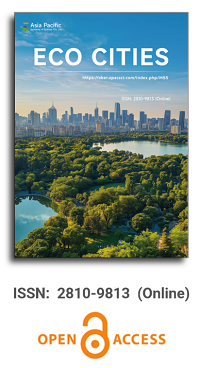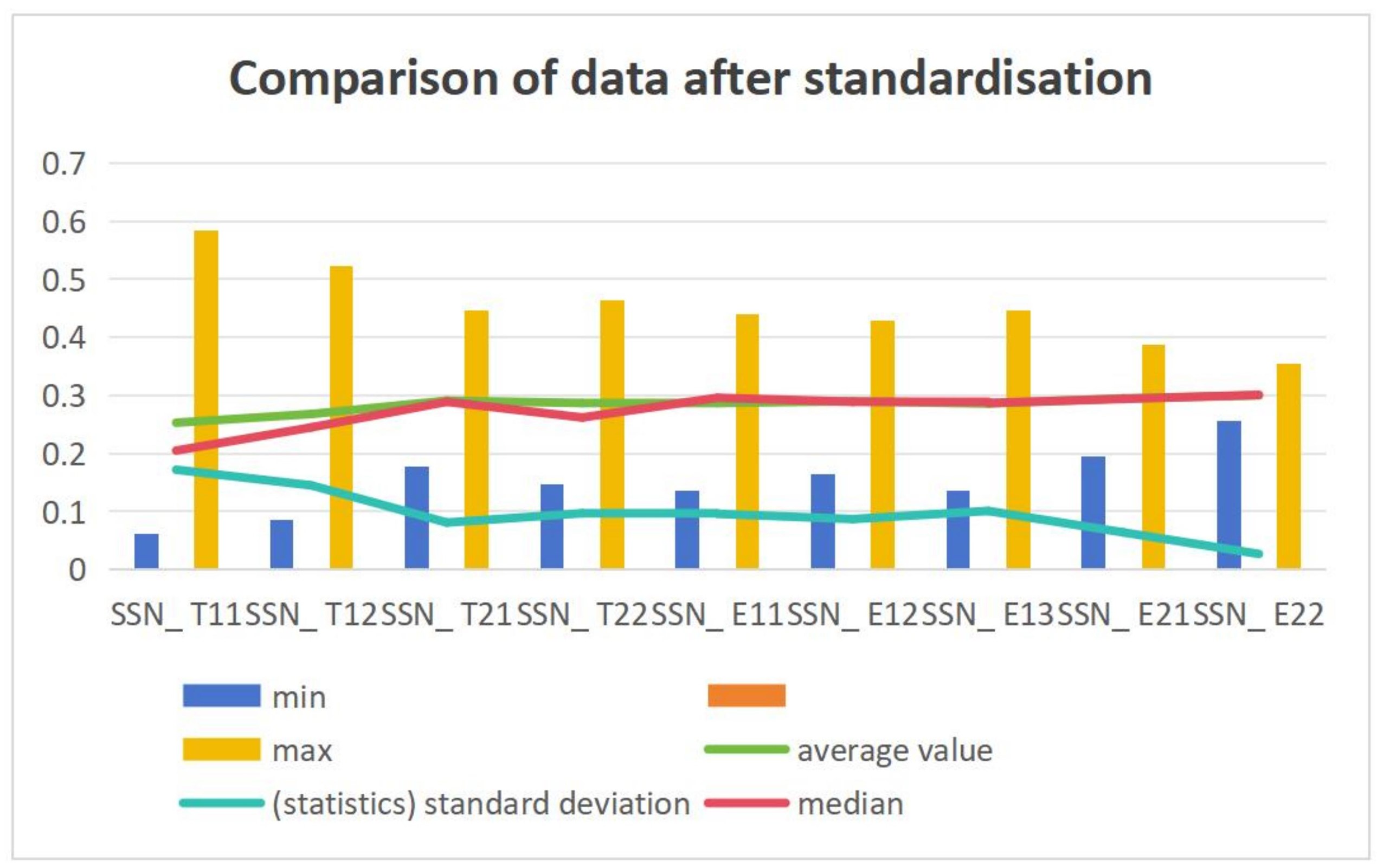


Development of community sustainability assessment methods in medium-sized cities in Chile
Vol 2, Issue 1, 2021
Download PDF
Abstract
Urban research related to sustainability is going through a rich experimental stage to explore different methods to deal with the current and future impacts of climate change on cities. This poses new challenges to the redevelopment of urban areas. These challenges are particularly relevant at a time of major urban transformation in the global south. This paper aims to develop a method to explore and evaluate the sustainable potential of urban morphology in the surrounding areas of medium-sized cities. The method involves six criteria related to the sustainability of built environment: scale, accessibility, diversity, connectivity, density and node. This approach applies to a community in Temuco, southern Chile. The results show the importance of building adaptive capacity to generate use diversity, which in turn promotes greater sustainability of urban morphology. On the other hand, the high population and housing density in residential areas reduce the pedestrian capacity of indoor streets, while the vertical mixed use and the change of urban block density are still the best response to promote social interaction and high collective activities in urban space. This paper summarizes the operational value of this method and reflects on the progress made in promoting the more sustainable urban form development of medium-sized cities in southern Chile in the future.
Keywords
References
- Robinson J, Roy A. Global urbanism and the nature of urban theory. International Journal of Urban and Regional Research 2015; 40(1): 181–186.
- Boyd E, Juhola S. Adaptive climate change governance for urban resilience. Urban Studies 2015; 52(7): 1234–1264.
- Steffen W, Grinevald J, Crutzen P, et al. The Anthropocene: Conceptual and historical perspectives. Philosophical Transactions the Royal Society A 2011; 369: 842–867.
- Zalasiewicz J, Williams M, Haywood A, et al. The Anthropocene: A new epoch of ecological time? Philosophical Transactions the Royal Society A 2011; 369: 835–884.
- Atkinson A. Urbanization: A brief episode in history. City 2014; 18(6): 609–632.
- Batty M. Cities in a completely urbanized world. Environment and Planning B: Planning and Design 2015; 42(3): 381–383.
- UN-Habitat. Planning sustainable cities: Global report on human settlements 2009 [Internet]. London: Routledge; 2009. Available from: http://unhabitat.org/books/global-report-on-human-settlements-2009-planning- sustainable-cities/.
- Banco Interamericano de Desarrollo. Valdivia capital sostenible: Plan de acción. Valdivia: Iniciativa Ciudades Emergentes y Sostenibles (ICES) (Spanish) [Valdivia sustainable capital: Action plan. Valdivia: Emerging and Sustainable Cities Initiative (ESCI)]. Brasilia: Banco Interamericano de Desarrollo; 2015.
- Inzulza J. La recuperación del diseño cívico como reconstrucción de lo local en la ciudad intermedia: El caso de Talca, Chile (Spanish) [The recovery of civic design as a reconstruction of the local in the intermediate city: The case of Talca, Chile]. Arquitectura Urbanismo Sustentabilidad 2014; 15(1): 4–8.
- Cebrián F, Panadero M. Ciudades medias. Formas de expansión urbana (Spanish) [Medium cities. Forms of urban sprawl]. Madrid: Biblioteca Nueva; 2013.
- Espinoza D, Zumelzu A, Burgos R, et al. Spatial transformations in intermediate cities: The case-study of Valdivia-Chile and its evolution post-earthquake. Arquitectura y Urbanismo 2016; 37(3): 1–22.
- Maturana F, Rojas A. Ciudades intermedias en Chile: territorios olvidados (Spanish) [Intermediate cities in Chile: Forgotten territories]. Santiago: RIL Editores; 2015.
- Ministerio de Vivienda y Urbanismo, Minvu. Diagnóstico urbano 1990–2006 (Spanish) [Urban diagnosis 1990–2006]. Santiago: Ministerio de Vivienda y Urbanismo, Minvu; 2006.
- Henríquez C. Modelando el crecimiento de ciudades medias chilenas: Hacia un desarrollo urbano sustentable (Spanish) [Modeling the growth of medium-sized Chilean cities: Towards a sustainable urban development]. Santiago de Chile: Ediciones UC; 2014.
- Grigonis V. World cities and urban form: Fragmented, polycentric, sustainable? Urban Design International 2013; 18(2): 182–183.
- Guevara T. Abordajes teóricos sobre las transformaciones sociales, económicas y territoriales en las ciudades latinoamericanas contemporáneas (Spanish) [Theoretical approaches to social, economic and territorial transformations in contemporary Latin American cities]. EURE 2015; 41(124): 5–24.
- Truffello R, Hidalgo R. Policentrismo en el Área Metropolitana de Santiago de Chile: restructuración comercial, movilidad y tipificación de subcentros (Spanish) [Polycentrism in the Metropolitan Area of Santiago de Chile: Commercial restructuring, mobility and typification of sub-centers]. EURE 2015; 41(122): 49–73.
- Salinas E, Pérez L. Procesos urbanos recientes en el Área Metropolitana de Concepción: Transformaciones morfológicas y tipologías de ocupación (Spanish) [Recent urban processes in the Metropolitan Area of conception: Morphological transformations and occupation typologies]. Revista de Geografía Norte Grande 2011; 49: 79–97.
- Borsdorf A, Hidalgo R, Sánchez R. A new model of urban development in Latin America: The gated communities and fenced cities in the metropolitan areas of Santiago de Chile and Valparaíso. Cities 2007; 24(5): 335–398.
- Atkinson A. Cities after oil-3: Collapse and the fate of cities. City 2008; 12(1): 79–106.
- Atkinson A. Where do we stand? Progress in acknowledging and confronting climate change and “peak oil”. City 2010; 14(3): 314–322.
- Janoschka M. El modelo de ciudad latinoamericana. Privatización y fragmentación del espacio urbano de Buenos Aires: El caso del Nordelta (Spanish) [The Latin American city model. Privatization and fragmentation of urban space in Buenos Aires: The case of Nordelta]. In: Ponce Herrero G (editor). La ciudad fragmentada: Nuevas formas de hábitat. Alicante: Universidad de Alicante; 2006. p. 219–253.
- Inzulza J, Wolff C, Vargas K. Acceso solar: Un derecho urbano para la calidad de vida vulnerado desde la gentrificación contemporánea. El caso de la comuna de Estación Central, Chile (Spanish) [Solar access: An urban right to quality of life violated by contemporary gentrification. The case of the commune of Estación Central, Chile]. Revista 180 2017; 39(2): 1–15.
- Ruiz-Tagle J. La persistencia de la segregación y la desigualdad en barrios socialmente diversos: Un estudio de caso en La Florida, Santiago (Spanish) [The persistence of segregation and inequality in socially diverse neighborhoods: A case study in La Florida, Santiago]. EURE 2016; 42(125): 81–108.
- López-Morales E. Gentrification in the global South. City 2015; 19(4): 564–573.
- Rosas J, Pereira P, Hidalgo, R. Producción inmobiliaria y reestructuración metropolitana en América Latina (Spanish) [Real estate production and metropolitan restructuring in Latin America]. Santiago de Chile: Pontificia Universidad Católica de Chile-Universidad de Sao Paulo; 2008.
- Zumelzu A. Forma urbana y sostenibilidad: Pasado, presente y desafíos. Una revisión (Spanish) [Urban form and sustainability: Past, present and challenges. A review]. Arquitectura Urbanismo Sustentabilidad 2016; 20(3): 77–85.
- Franchi-Arzola I, Martin-Vide J, Henríquez C. Sustainability assessment in development planning in sub–national territories: Regional development strategies in Chile. Sustainability 2018; 10(5): 1398.
- Sampson RJ, Morenoff JD, Gannon-Rowley T. Assessing “neighborhood effects”: Social processes and new directions in research. Annual Review of Sociology 2002; 28: 443–478.
- Singh R. Factors affecting walkability in neighborhoods. Procedia-Social and Behavioral Sciences 2016; 216: 643–654.
- Wu J, Ta N, Song Y, et al. Urban form breeds neighborhood vibrancy: A case study using GPS-based activity in suburban Beijing. Cities 2018; 74: 100–108.
- Hosni J, Zumelzu A. Assessing nodality in neighbourhoods in transformation: A concept of sustainable urban form. The case study of Rahue Bajo, Osorno, Chile. Sustainable Development 2019; 27(2): 1–13.
- Rodríguez L, Zumelzu A, Andersen K. Versatility in the urban morphology of a bohemian neighbourhood in the city of Valdivia, Chile. Revista 180 2018; 41: 78–85. doi: 10.32995/rev180.num-41.(2018).art-429.
- Ellin N. Integral urbanism. New York: Routledge; 2006.
- Tapia V. What we mean by neighbourhood? The trajectory of neighbourhood concept and some notes for discussion. Revista Antropologías del Sur 2015; 3: 121–135.
- Maretto M. Sustainable urbanism: The role of urban morphology. Urban Morphology 2014; 18(2): 163–174.
- Zumelzu A. Sustainable transformation of the cities: Urban design pragmatics to achieve a sustainable city. Eindhoven: Technische Universiteit Eindhoven; 2015.
- Barton H. Sustainable communities: The potential of eco-neighborhoods. London: Earthscan; 2000.
- Frey H. Designing the city: Towards a more sustainable urban form. London: Spon Press; 1999.
- Blanco J. Hacia el diseño y gestión de barrios sustentables en Chile (Spanish) [Towards the design and management of sustainable neighborhoods in Chile]. Revista INVI 2015; 31(86): 203–214.
- Gravano A. Antropología de lo barrial. Estudios sobre producción simbólica de la vida urbana (Spanish) [Anthropology of the neighborhood. Studies on the symbolic production of urban life]. Buenos Aires: Espacio Editorial; 2003.
- Dempsey N, Brown C, Raman S, et al. Elements of urban form. In: Jenks M, Jones C (editors). Dimensions of the sustainable city. Dordrecht: Springer; 2010.
- Williams K, Burton E, Jenks M. Achieving sustainable urban form. London: E&FN Spon; 2000.
- Ehlers E. City models in theory and practice: A cross-cultural perspective. Urban Morphology 2011; 15(2): 97–119.
- Jenks M, Jones C. Dimensions of the sustainable city. Dordrecht: Springer; 2010.
- Kropf K. Ambiguity in the definition of built form. Urban Morphology 2014; 18(1): 41–57.
- Talen E. Sprawl retrofit: Sustainable urban form in unsustainable places. Environment and Planning B: Planning and Design 2011; 38(6): 952–978.
- Farr D. Sustainable urbanism: Urban design with nature. New Jersey: Wiley & Sons; 2008.
- Karimi K. Retrofitting suburbia: Urban design solutions for redesigning suburbs. Journal of Urban Design 2013; 18(1): 168–170.
- Luederitz C, Lang D, Von Wehrden H. A systematic review of guiding principles for sustainable urban neighborhood development. Landscape and Urban Planning 2013; 118(10): 40–52.
- Ryn SV, Calthorpe P. Sustainable communities: A new design synthesis for cities, suburbs and towns. Nueva York: New Catalyst Books; 2008.
- Talen E. Design for diversity: Exploring socially mixed neighborhoods. London: Architectural Press; 2008.
- Zumelzu A, Doevendans K. Modularity and sustainability: Eindhoven as an example of pragmatic sustainable design. Urban Design International 2016; 21(1): 93–110.
- Caniggia G, Maffei G. Architectural composition and building typology, interpreting basic building. Firenze: Alinea; 2001.
- Marston S, Jones J, Woodward K. Human geography without scale. Transactions of the Institute of British Geographers NS 2005; 30: 416–432.
- Salthe S. Self-organization of/in hierarchically structured systems. Systems Research 1989; 6(3): 199–208.
- Wilson A. Complex spatial systems: The modelling foundations of urban and regional analysis. Harlow: Prentice-Hall; 2000.
- Howitt R. Scale and the other: Levinas and geography. Geoforum 2002; 33: 299–313.
- Kärrholm M. The scaling of sustainable urban form: A case of scaled-related issues and sustainable planning in Mälmo, Sweden. European Planning Studies 2011; 19(1): 97–112.
- Oliveira V. Morpho: A methodology for assessing urban form. Urban Morphology 2013; 17(1): 21–33.
- Siksna A. The effects of block size and form in American and Australian cities. Urban Morphology 1997; 1(1): 19–33.
- Sevtsuk A, Kalvo R, Ekmekci O. Pedestrian accessibility in grid layouts: The role of block, plot and street dimensions. Urban Morphology 2016; 20(2): 89–106.
- Krier L. The city within the city. Architectural Design 1984; 54(1): 70–105.
- Jacobs J. The death and life of great American cities. Nueva York: Vintage Books; 1961.
- Lynch K. Good city form. Cambridge: MIT Press; 1981.
- Sternberg E. An integrative theory of urban design. Journal of the Planning Association 2000; 66(3): 265–278.
- Barton H, Grant M, Guise R. Shaping neighborhoods: For local health and global sustainability. London: Routledge; 2010.
- Williams K, Dair C, Lindsay M. Neighborhood design and sustainable lifestyles. In: Jenks M, Jones C (editors). Dimensions of the sustainable city. Dordrecht: Springer; 2010. p. 183–214.
- Ewing R, Keith W, Steve W, et al. Don Growing Cooler: The evidence on urban development and climate change. Washington, D.C.: Urban Land Institute; 2008.
- Hillier B, Hanson J. The social logic of space. Cambridge: Cambridge University Press; 1984.
- Alexander C. A city is not a tree. Architectural Forum 1965; 122(1): 58–62.
- Bosselmann P. Urban transformation: Understanding city design and form. Washington, D.C.: Island Press; 2009.
- Cervero R. Linking urban transport and land use in developing countries. Journal of Transport and Land Use 2013; 6(1): 7–24.
- Oden M. Equity: The forgotten e in sustainable development. In: Moore S (editor). Pragmatic sustainability, theoretical and practical tools. Nueva York: Routledge; 2010. p. 30–49.
- Frey H, Bagaeen S. Adapting the city. In: Jenks M, Jones C (editors). Dimensions of the sustainable city. Dordrecht: Springer; 2010.
- Batty M. Cities and complexity: Understanding cities with celular autómata, agentbased, models and fractals. Cambridge: MIT Press; 2005.
- Winston N. Sustainable communities? A comparative perspective on urban housing in the European Union. European Planning Studies 2013; 22(7): 1387–1406. doi: 10.1080/09654313.2013.788612.
- Vaughan L. Space syntax observation manual. London: University College of London; 2001.
- Marchant C, Frick JP, Vergara L. Urban growth trends in midsize Chilean cities: The case of Temuco. Brazilian Journal of Urban Management 2016; 8(3): 163–174.
- Zumelzu A, Estrada M, Jara C, et al. Sostenibilidad de la forma urbana en un barrio Corvi: El caso de la Villa Llaima, Temuco (Spanish) [Sustainability of urban form in a Corvi neighborhood: The case of Villa Llaima, Temuco]. In: Torrent T, Barría A, Zumelzu V, et al. (editors). Patrimonio moderno y sustentabilidad: De la ciudad al territorio. Valdivia: Docomomo Chile; 2018. p. 176–180.
Supporting Agencies
Copyright (c) 2021 Antonio Zumelzu, Daniel Espinoza
License URL: https://creativecommons.org/licenses/by/4.0

This site is licensed under a Creative Commons Attribution 4.0 International License (CC BY 4.0).

Chinese Academy of Sciences, China
Indexing & Archiving
Asia Pacific Academy of Science Pte. Ltd. (APACSCI) specializes in international journal publishing. APACSCI adopts the open access publishing model and provides an important communication bridge for academic groups whose interest fields include engineering, technology, medicine, computer, mathematics, agriculture and forestry, and environment.



.jpg)

.jpg)



